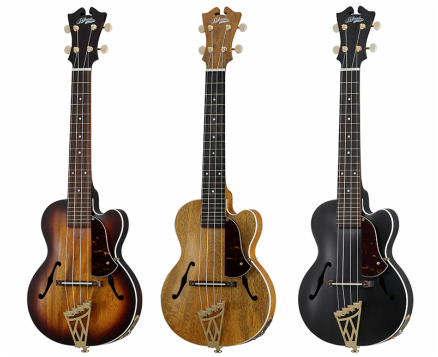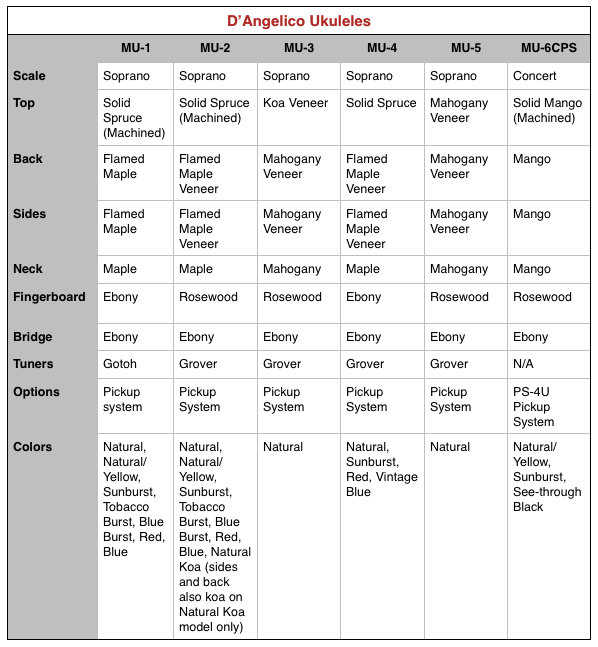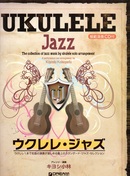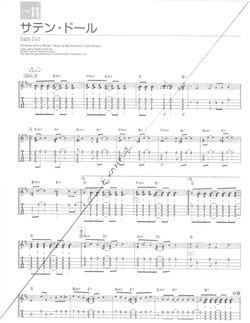|
The Acoustic Sound Organization ("AcoSoundOrg") is a virtual panoply covering all things ukulele! Video lessons, local performances in Tokyo, a blog, music sales, and much, much more. I first learned of AcoSoundOrg through its YouTube postings. Frankly, I'm not sure who comprises the actual organization but there seem to be several regulars covering everything from classic Rock and Roll to Jazz and beyond. Some are better than others. All are interesting. Given my preference for Jazz I recently watched a duo play a spirited arrangement of Take the A Train. If you are patient you can find a some chord charts on their website for downloading. I found a TAB of Moon River in JPEG format that I was able to print out after adding it to Apple Images.
Enjoy!
2 Comments
I often comb YouTube looking for videos of Japanese ukulele players. Yesterday I decided to fiddle with my search filter a bit but got frustrated. I kept seeing dozens of videos of Japanese playing コーヒールンバ、"Coffee Rumba". Many had high view counts. The one I clicked on was played well and the tune was very catchy, but strangely I'd never heard it before. I doubt you have either. I searched on the title, which lead to one thing, then another, and lo and behold I realized that I'd stumbled on an interesting story.
Coffee Rumba was composed by Venezuelan Hugo Blanco when he was just 18 years old. The tune soon became a number 1 hit in Argentina and Japan, where in 1961 it was recorded by singer Nishida Sachiko. (Click on the album cover above to hear it.) As a sign of just how insular Japan still was at the time, when asked if she drank coffee, Nishida replied, "What's that?". It's reported she did eventually pick up the habit. A word about Blanco (1940 - 2015). At 15 Blanco taught himself to play the cuatro (you can read about it here), a ukulele-like 4-string instrument also hailing from Portugal. Three short years later he composed Moliendo Cafe, which became Coffee Rumba in Japan. After that tune climbed the charts Blanco went on to fuse Cuban and a popular Venezuelan style of music called joropo, into what is now known as "orquídea". You can hear Blanco's version of the tune here. I love the cool maracas in the background! Here's my take-away from this. As an American I'm used to our music being the worldwide inspiration for almost everything musical. That this tune never made it to the US charts yet blossomed in Latin American and Japan shouldn't surprise me. Yet it does. But this too gives me hope. Music is an international language in which we are all fluent. We may not understand the words but we recognize the emotions behind what is played and that brings us closer together. Viva la musica! 音楽万歳! Long Live Music! Early this morning I saw a posting on RIO's Facebook page with a link to a video of his original composition CO-CO-ME-RO. Sleeply I clicked through and was immediately smitten!
You know that feeling you get when you hear something once and know that you'll be listening for a long time? I had that. For me, the music has to be sufficiently complex, usually jazzy (although not always), and take me to places I've always felt I've wanted to go or to places that I've already been to. That's what I felt the moment I started listening to CO-CO-ME-RO. That's unusual for me. It's even more unusual that it would come from as young and novel a performer as RIO. He's only something like 16 and yet he plays, performs, and composes like someone much older. OK, so I immediately purchased the album. Not surprisingly I've been playing it all day. It's a very uniform album- every tune has something that I want to hear. Yet again, unusual. On I ~Alone~ RIO plays with Aska Kaneko (violin) and Kojima (piano) to create a very Django-Grappelli vibe. This is very good stuff... and Kaneko-san is a talented violinist. Perhaps I'll review the album at some point, but first let me encourage you to go and purchase it. See for yourself. Feel free to post your comments and let me know what you think. I found the Holy Grail: an archtop D’Angelico ukulele! Master luthier John D’Angelico (1905 - 1964), best known for his exquisitely built and luxuriously sounding archtop guitars, built very few ukuleles. Even his guitars are rare. The roughly 1,100 he built in his New York workshop are coveted by jazz musicians for their superior craftsmanship, unique tone, and playability. Unfortunately, the number of ukuleles D’Angelico built can probably be counted on your right hand. So, how did I find a D’Angelico ukulele? It was a circuitous route beginning with postings on the Ukulele Underground, a few YouTube videos, and finally a Japanese website run by Korg which unfortunately turned out to be a dead end. What I did find was a line of D’Angelico-inspired archtop ukuleles recently built by an unnamed Japanese workshop that had once licensed the brand from its then current owner. After reading through the promotional literature on the Japanese website, I was still no wiser. Not to be denied, I dug a bit deeper. Here’s what I know… Sometime after John D’Angelico and his successors left the business, John Ferolito Sr., a co-founder of Arizona Ice Tea, purchased the rights to the D’Angelico brand but never fully developed the brand. The brand was again sold in 2013 to John Ferolito Jr. and partners Brenden Cohen and Steve Pisani. The new owners revived the brand and have started marketing a reasonably priced line of guitars meticulously built using measurements obtained by imaging some of the instruments D’Angelico himself made. Here’s where it gets a bit unclear… It appears that before 2013 the brand was licensed to a Japanese manufacturer who developed a line of archtop ukuleles. The line was available only in Japan and perhaps because of that, production soon became unsustainable and the manufacturer filed for bankruptcy. Keyboard manufacturer Korg offered to help move the remaining stock through its sales channels, but only in Japan. At the 2014 NAAM a few D’Angelico ukes made it to the show floor and were very favorably reviewed by Hawaii Music Supply’s staff and were judged to be a more well-rounded instrument than what was being offered by its closest rival, Eastman. On the Korg site you can find the now defunct line of D’Angelico archtop ukuleles. Six models were offered, five sopranos and a concert size. (See specs below.) Some stock is still available in Japan but once sold, these instruments will become unavailable. I hope D’Angelico will someday reconsider building archtop ukuleles. I know it would make me very happy. How about you? Let me know! Japanese are world-class hobbyists. Go to any bookstore in Japan and there are rows upon rows of how-to books and magazines for nearly every amateur pursuit imaginable. An industry has been built around helping Japanese amateurs get really good at their craft. Music, of course, is a popular hobby and ukulele is no exception. In my opinion, these books are as good or better than anything that can be found in the US. The last time I was in Japan I went to the bookstore Junkudo in Ikebukuro-ward and on the 9th floor lost myself in shelf after shelf of ukulele books. I came home with two: Ukulele Jazz (Kiyoshi Kobayashi) and Movie Music: Jazz Arrangements for Solo Ukulele by Hiroyuki “Tommy” Tominaga. In this post I’ll review the first. Ukulele Jazz is a collection of 27 well-arranged tunes in both notation and tablature. Each tune has a page or two of written explanation in Japanese complete with fingering charts, but unless you read Japanese they won’t be of much help. However, if you’re an intermediate player you’ll have no problem working your way through the pieces. Author and Arranger Kiyoshi Kobayashi was trained as a classical guitarist so I find his chord inversions to be very logically laid out on the fretboard and the melodies always come out the better for that. You can hear me playing Satin Doll from this book on the UKULELEjapan.com website. The book comes with a CD with each piece played in full. It’s helpful to listen to the CD track before starting work on the piece. Then, after you’ve gotten fairly adept at playing the piece, play along with it to get the nuances that you might have missed on your own. You can also go to YouTube and search for Lami Jeon, a young Korean woman, who has filmed herself playing many of these pieces. Watch her left hand as she plays to get tips on which fingers to use. All the pieces in the book can be played using a flat pick, your thumb, or by finger picking. Kobayashi appears to use his thumb and fingers to pick and strum the uke. I seem to cycle between all three methods depending on what I’m playing and the sound I want to create. If you’re not planning a trip to Japan anytime soon, you can find a link at UKULELEjapan which will take you to CDJapan where you can place an order in US dollars. Sample pages: Yours in uke,
UkeKev Two stops from Tokyo Station on the Chuo-line and you're in a musical paradise! Tokyo Station is the terminus for the Chuo-line so unless you board the wrong line, you're bound to reach your destination. Board the train with the orange stripe at its head so you'll be closest to the proper exit. After a brief stop at Kanda Station disembark at Ochanomizu. Exit using the west gate.
The map above show the location of several of the Shimokura stores but trust me, there's plenty of other stores to browse! You'll need very little or no knowledge of Japanese to navigate your way to the stores. Signs with the word Guitar or ギター are ubiquitous and if all else fails, look for instruments in the window. You'll find a lot of American instruments in these stores but you'll also find Japanese brands as well- some made in Japan, some made in China. There are plenty of stores in Ochanomizu that specialize in selling used instruments but be warned, they are much more expensive than what you'd find here in the States. Takumi Ukuleles' Kiwaya, Lo Prinzi, Famous are widely distributed, Seilin's T's Ukulele are a bit harder to find but quality instruments. There are a number of luthiers in Japan making some really beautiful instruments but you'll find that like most Japanese instruments, they tend to be on the upper end of the price scale. But you do get what you pay for, don't you... Korg of keyboard fame, recently released in Japan a full line of D'Angelico archtop ukuleles. I've seen the YouTubes but have yet to get my hands on one so let me know if you find one and what you think! Japan is one of the last countries in the world with strong CD sales which, in a country short on living space, seems just a bit counter intuitive. This means that there's a lot of CD shops with new and used CDs of every variety! Disk Union, the largest chain, sells both used and new CD's. I've found more of the most arcane, out-of-print, hard to find CDs at Disk Union than anywhere I've ever been! Happy hunting and be sure to share your finds here! |
AuthorI'm an amateur ukulele player who happens to be fluent in Japanese. I hope that I can inspire you to learn more about the ukulele, Japan, or better yet, BOTH! Archives
February 2021
Categories |







 RSS Feed
RSS Feed